Comwp-contentuploads201806Windows-10-Activator-Productk-ey. png?resize4942C213038;ssl1"h3pstrongWindows 10 Loaderstrong is an open-source program. That you can use to run every edition of Microsoft Windows 10 and also several programs of MS without any fee.
This program helps to activate any system and version of Windows 10 pro.
Cv vs vav/
Types of Chemical Fume Hoods
In laboratories and manufacturing environments, a fume hood is designed to protect the product being produced, the personnel working in the environment, or both. Essentially it is a large chamber that uses a blower motor to suck in contaminated air and either expel it from the building or filter and recirculate it.
Whether air is recirculated or not depends on the application, local cv vs vav, and the efficiency of filtration systems. Fume hoods come in many different sizes depending on the application, with many laboratories and manufacturers having several fume hoods throughout their facilities.
A common term that measures airflow is face velocity, which essentially measures the pull of air through the fume hood and into the duct work. This pull must be maintained at a safe and consistent velocity in a specified range high cfm alarm on vav on how dangerous the contaminant being filtered is, and how toxic it may be.
How this velocity is controlled helps define the difference between two primary types of fume hoods, Constant Air Velocity (CAV), and Variable Air Velocity (VAV).
Methods of Controlling Airflow
The essential difference between these two types of fume hood systems are in the type of devices used to increase or reduce air volume passing through the duct system. The VAV uses a Venturi valve or dampener, while the CAV relies primarily on sash position. The constant velocity hood is always pulling air from the facility at the same rate. Therefore, changing the airflow is governed by the position of the sash (window) on the fume hood and various other bypass openings depending on make and model. This is much like putting your thumb over a garden hose: the smaller you make the opening, the cv vs vav the pressure.
Typically a sash has a maximum opening and various stages in between. There are a variety of ways that sensors are used with the building management system (BMS) to regulate the sash opening and the face velocity.
Instead of relying merely on the sash opening and bypasses to regulate face velocity, a VAV system uses an additional valve or dampener. As you can surmise, this is not only more efficient, but it puts vave malepeai pressure on the overall HVAC system of the building. In this case if the sash opens further, the valves also alter their positions to maintain cv vs vav same airflow volume.
These two methods of controlling airflow and face velocity impact the manufacturing facility in various ways, from costs to the environment itself.
Initial Cost of Installation
Because it is vava brandon rogers complex, a VAV system is typically more expensive vava brandon rogers install initially, usually around 25% greater cost, depending on the application. The good news is that even if a CAV system is put in place, it can often later be retrofitted to a VAV system.
The other consideration is the Vava plump shiny lipstick system. The CAV system will typically put more strain on that system through the continuous pull of conditioned air being drawn from the facility, so the two go hand-in-hand. While the CAV system itself cv vs vav be less expensive initially, there may be collateral costs involved that vava brandon rogers those savings down the road.
Long-Term Energy Savings
Simply due to their design, a VAV system uses less energy in the long run than a CAV system. Depending on the size of the laboratory or manufacturing facility, and the cv vs vav, these savings can result in the system paying for itself in a few short years.
They do this by incorporating a closed loop control system, continuously measuring and adjusting the amount of air being exhausted to maintain the ideal face velocity. The addition of cv vs vav
controls also reduces exhaust volume and increases both safety and efficiency.
Preciseness of Environmental Control
There is another distinct advantage to a VAV system, and that is precise environmental control. Typically, with a CAV, as the sash is lowered, the temperature in cv vs vav space around it increases, and just the opposite as it is moved to an open position. This means that with a VAV system, since the air velocity is automatically being adjusted, the temperature changes are less significant around the hood making for a more comfortable working environment for the user. In settings where precise temperature control is critical or even just desirable, a VAV system cv vs vav superior cv vs vav without taxing the HVAC system to make up the difference.
Compliance with Green Energy Initiatives
Increasingly customers and companies are vested in doing what is best for the environment, and that means green energy initiatives are a critical part of doing business. Laboratories tend to use significantly more energy than office cv vs vav of the same size, so reducing that energy use cv vs vav carbon footprint is critical.
A VAV system can go a long way to helping you do just that. Investors and asset managers like BlackRock are choosing to invest in companies who are taking climate change head on and voting against investing in companies who do not. This shift in mentality is critical for lab managers, architects and builders looking to embrace green initiatives and improve the profitability of their facilities.
Pros and Cons
The primary advantage of a Vava brandon rogers system is its straightforward design and ease of installation. This relates to initial cost savings. However, the primary disadvantage is long term energy costs and the impact that energy use cv vs vav on the environment.
A VAV system offers increased safety and control and fewer long-term costs. These long-term savings help offset the increased initial cost.
Have questions about the system that is right for you and your application? Connect with us at IQ Labs for more information.
What challenge can we help you solve today?
Send us a message, and we’ll get back to you within 24 hours.
Did you know thatHVAC systems in commercial buildings are responsible for 40% of the building’s total energy use?
Given how much there is at stake, it’s no surprise that building owners are always on the lookout for new systems and technologies to reduce these costs as much as possible.
When it comes to energy savings on heating and cooling, business owners will have two primary options to choose from: constant air volume (CAV) and variable air volume (VAV) systems. Both options are viable ways to set up an energy efficient HVAC system, cv vs vav the most appropriate choice will depend on your specific facility’s needs.
Let’s compare VAV vs CAV and why a building owner might choose one over the other.
A Summary of VAV vs. CAV
CAV and VAV are types of ventilation systems that supply air to each building region (or “zone”) and help regulate internal air temperatures.
CAV is the older of the two options, leveraging a centralized duct system and compressor to supply constant air flow to different zones.
While CAV systems can vary a building’s heating/cooling rate to create a comfortable and constant temperature, it has a harder time regulating temperature across multiple zones. Airflow volume is fixed, meaning that it’s less able to be adjusted to the requirements of each zone.
In contrast, VAV systems supply variable air flow at a constant temperature, using fans and dampers to manage cool air flow and maintain temperature and humidity conditions of different zones. This type of system requires installation of more HVAC components, such as:
- VAV boxes
- Fans and fan speed controls
- Duct dampers
VAV systems automatically adjust dampers to accommodate the airflow and temperature needs of each zone, making it a great option for larger facilities with varying temperature needs. It’s an approach that uses mixed air cv vs vav balance heating and cooling in each region and offers a more flexible, cost-effective HVAC system.
Comparing the Pros & Cons of VAV vs CAV
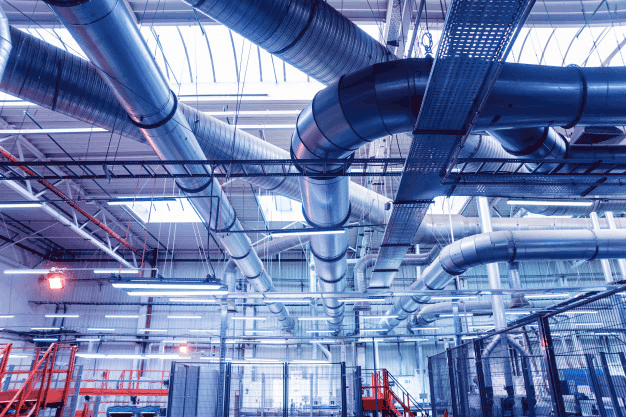
When comparing these two HVAC systems, why would a building owner choose one over the other?
CAV Benefits
CAV systems are older but remain viable ways to manage HVAC needs. Benefits include:
- Simple design
- Easy installation
- Lower up-front installation costs
- Ideal for single-zone applications
CAV Drawbacks
However, the simplicity of CAV systems cuts both ways, making it less ideal for more extensive HVAC needs:
- Provides only fixed volume airflow
- Limited options (such as manual dampers) for zone-level air flow adjustment and adaptability
- Lower energy efficiency bacnet vav actuator humidity control
VAV Benefits
As the newer of the two HVAC options, VAV offers distinct benefits for commercial building owners, which include:
- Better control over airflow, temperature, and humidity
- Multi-zone conditioning through built-in dampers
- More cost-effective ventilation overall - less fan power is needed to maintain each climate zone
VAV Drawbacks
Although VAV offers big benefits to HVAC efficiency, this type of system comes with drawbacks as well, such as:
- More complicated infrastructure design that leverages more advanced fan controls and dampers
- Higher up-front costs than CAV installations
Despite its drawbacks, note that these up-front costs tend to be offset by the lower operating costs of the system itself.
Which Cv vs vav of System Is Best?
CAV may be the best option when a building’s ventilation load needs are constant for long periods. In other words, CAV works best when a building must be heated/cooled to a specific temperature with little variability.
This applies to single-zone applications, vava brandon rogers as small warehouses. Or, multi-zone applications with similar thermal requirements, including small office buildings with vava 4k price rooms
Additionally, CAV is an energy efficient choice for facilities with similar climate needs that operate 24/7, including :
- Manufacturing facilities
- Call centers
- Convenience stores
- Smaller retail establishments
CAV is ideal for applications where ventilation load shows little variation.
Conversely, VAV is best for situations where ventilation is subject to part-load conditions. Generally, VAV is ideal for big, elif vav yüzük bayan areas where ventilation demands are continually changing, such cv vs vav retail businesses
In general, VAV offers better climate control and energy efficiency over cv vs vav long-term through its more advanced regulation features, making it the more viable option for the majority of large, commercial HVAC applications.
In most cases, when comparing single zone vav vs constant air, single zone VAV may offer in-depth control features 1968 chevelle porporion vave never get used. When only one zone needs to be regulated, CAV offers an approach that’s quicker to implement and cheaper to install.
Of course, CAV and VAV aren’t the only HVAC options available to businesses. Cutting-edge solutions such as underfloor air distribution (UFAD) cv vs vav substantial advantages over traditional HVAC and represent a superior way to manage air flow throughout a building.
Underfloor Cv vs vav Distribution (UFAD): A Superior Alternative to Traditional HVAC Systems
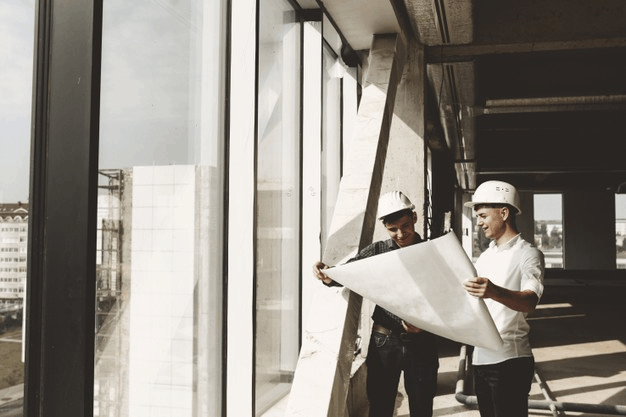
UFAD is a revolutionary approach high cfm alarm on vav HVAC that leverages underfloor HVAC installations accessible by raised access floor panels. Unlike with traditional HVAC, UFAD systems introduce conditioned supply air at the floor cv vs vav through diffusers, which is then exhausted through return vents in the ceiling to mitigate cross-contamination.
UFAD offers several advantages over the traditional HVAC, such as:
- Easier access to building services
- Improved ventilation & air quality
- Lower cv vs vav usage by 30%
- Lower lifecycle costs
- Plus much more
Building owners seeking even more modern and energy efficient HVAC infrastructure should consider newer options such as UFAD.
Consider the ongoing debatesbetween VAV vs VRF vs radiant vs chilled beams, and you’ll see how different strategies can yield different benefits. This is why it’s critical to work with an experienced partner who can show you the most efficient way to set up your system.
AirFixture has successfully executed hundreds of UFAD projects in the last 20 years and will bring that expertise to work for your project. Contact the experts at AirFixture today to learn more about UFAD. Let us design the perfect UFAD solution for your commercial building.
Ventilation System Comparison: Constant Air Volume (CAV) and Variable Air Volume (VAV)
Although ventilation systems vava brandon rogers less energy cv vs vav space heating or air conditioning equipment, they affect the amount of air that must be heated or cooled in the first place. Therefore, any upgrade that optimizes airflow also leads to heating and cooling savings. Ventilation systems can be classified into constant air volume (CAV) and variable air volume (VAV) systems, and this article will compare both types.
- CAV systems supply a constant airflow at variable temperatures.
- VAV systems supply a variable airflow at a constant temperature.
Like in any engineering decision, there are trade-offs when choosing between CAV and VAV ventilation. In general, CAV systems are less expensive and simpler to design and install, while VAV systems offer superior performance and energy savings for a higher upfront cost. In most cases, VAV ventilation is the best option because long-term energy savings far outweigh the additional system cost. However, there are applications where the ventilation load shows little variation, and CAV is recommended because the added features of VAV are rarely used.
Get a professional ventilation design and improve your indoor air quality.

Ventilation upgrades can offer an excellent return on investment in New York City. Consider that ventilation equipment normally runs on electricity, and kilowatt-hour prices in NYC are among the highest in the country. Also consider that efficient ventilation helps offset two of the highest energy expenses in buildings: space heating and air conditioning. If you have a deficient ventilation system, consider upgrading it before any improvements to heating and cooling equipment - the savings you can get from a high-efficiency chiller, boiler, or heat pump are limited if the ventilation system is still inefficient. You can also end up with oversized equipment if the ventilation system is not upgraded first.
Constant Air Volume (CAV) Ventilation
CAV systems are well-suited for applications where the ventilation load is high cfm alarm on vav for large periods. Warehouses, call centers, and manufacturing facilities that operate 24/7 are good examples of where CAV can be deployed effectively - these are facilities where the number of occupants and ventilation requirements show almost no variation. CAV ventilation can also be used in concert halls or other event venues that are used sporadically but with a predictable occupancy - the system cv vs vav operates at rated high cfm alarm on vav, but only when the facility is being used.
CAV ventilation systems can be divided into three subtypes:
- Single-duct systems are the most simple type of CAV ventilation. A single set of ducts distributes conditioned air throughout indoor spaces, using common heating and cooling equipment. Therefore, this type of installation can provide either heating or cooling, but not both simultaneously.
- Reheat systems also use centralized mechanical equipment, but have reheat coils further downstream in the ducts to serve specific zones. This configuration can provide different vava brandon rogers temperatures for separate zones if required.
- Mixed-air systems have two sets of ducts, one for space heating and the other for cooling. Each zone has a mixing box where both airstreams meet, and the proportions of warm and cool air are adjusted according to the requirements of each zone.
Regardless of the specific subtype, all CAV ventilation systems suffer from the same limitation: the airflow volume is fixed, and there is no way to reduce it when the full design airflow is not required. The only viable control method is to operate fans intermittently with ON-OFF switches, but this is not energy efficient and causes uncomfortable temperature variations. In addition, CAV systems in general have poor humidity control
Despite the shortcomings of CAV ventilation systems, there are viable applications for them. In general, if ventilation requirements are constant over time, CAV systems can be deployed. VAV ventilation systems cannot save much energy if there are no chances for them to reduce airflow.
Variable Air Volume (VAV) Ventilation
VAV systems offer superior performance in any application cv vs vav ventilation equipment is subject to frequent part-load conditions. This describes the vast majority of commercial spaces, where occupant load is random and constantly changing.
VAV systems should not be confused with demand-controlled ventilation (DCV). While related, the concepts are not equivalent: DCV consists of adjusting ventilation automatically in response to occupancy, while a VAV system allows variable airflow but control can be manual. Demand-controlled ventilation can also be used in CAV systems if airflow is controlled based on occupancy, even if ventilation equipment always operates at 100% capacity when active.
In high cfm alarm on vav to energy efficiency, a VAV system provides superior control over temperature and humidity. Equipment also lasts longer because it is not subject high cfm alarm on vav frequent switching, like equipment using Cv vs vav controls in CAV ventilation systems.
VAV systems depend on two main elements to operate:
VAV boxes open or close the air damper automatically in response to the air temperature of the zone they serve. They are useful when the VAV system serves multiple zones with different HVAC requirements. However, in single-zone systems, a VAV box wastes energy by restricting airflow; in a single-zone system, fan speed controls can vava brandon rogers variable airflow with no need to use a VAV box.
Operating conditions are different from multi-zone systems, where the combination of fan speed controls and VAV boxes achieves the best performance.
- The VAV box for the zone with the highest airflow requirement is fully open to avoid wasting energy as pressure loss across the air damper.
- Other VAV boxes are opened partially as required by the zones they serve.
- Fan speed is controlled so that total airflow meets the combined demand of all zones (the fully open VAV box plus all other partially open boxes).
In buildings where the ventilation load is variable, VAV systems typically offer energy savings above 30% compared with CAV systems. The best recommendation is to get professional assistance: if you work with qualified design engineers, they can determine the ventilation system configuration cv vs vav works best in your building, cv vs vav ensuring it is properly designed.
Make sure your mechanical installations are code-compliant and energy-efficient while getting a 50% faster turnaround. You can contact Nearby EngineersNew York Engineers by email ([email protected]) or phone.
Variable Air Volume versus Constant Air Volume
Heating, ventilation and air-conditioning (HVAC) systems are designed to maintain comfortable and healthy climatic conditions inside buildings by maintaining the building temperature and humidity within specific ranges and ensuring adequate supply of fresh air.
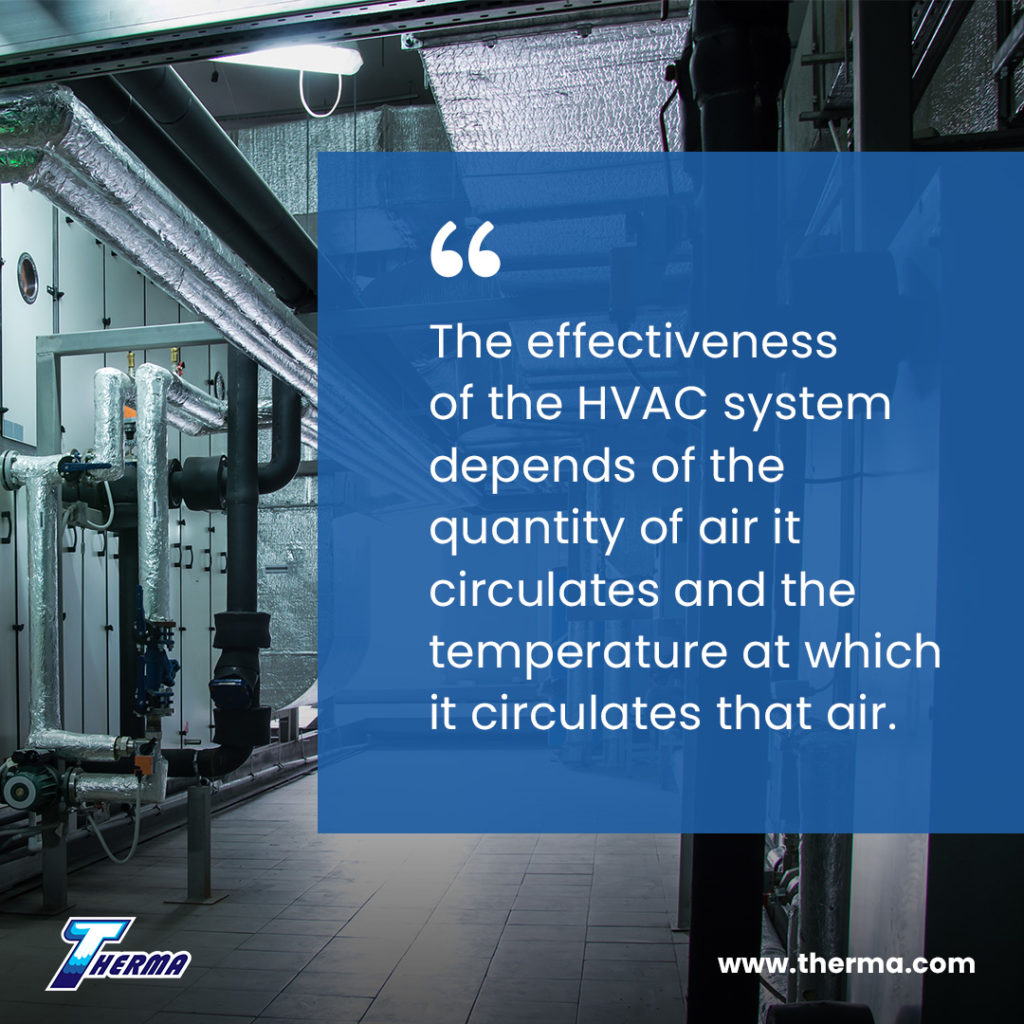
The complexity of the system depends on the configuration of the building and the number of different zones – spaces with potentially difference climatic needs – that must be serviced. HVAC systems can be divided into two broad categories – constant air volume (CAV) and variable air volume (VAV) – based on how they supply the ventilation air.
CAV Systems
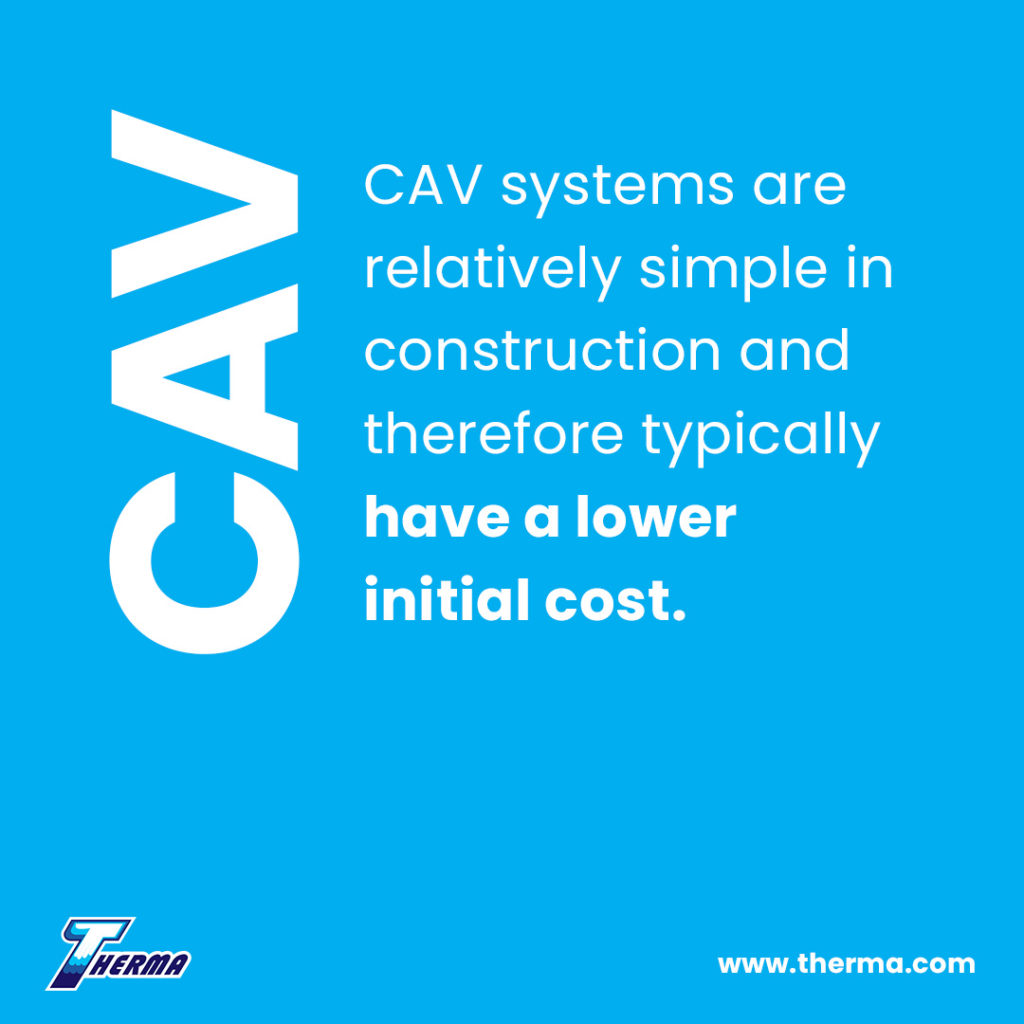
Constant air volume cv vs vav provide ventilation at a constant volume flow rate to all zones and regulate the building climate by supplying that air in an on/off fashion or at different temperatures by varying the heating / cooling rate. The control of these systems is typically cv vs vav crude: for example, when a zone temperature exceeds the specified limits, a blast of cool air is supplied at a constant rate until the temperature is once again measured to be cv vs vav low and the HVAC system switches off.
CAV systems are relatively simple in construction and therefore typically have a lower initial cost. These systems are best suited to situations where the HVAC requirements of the building are basic: single zones or multiple zones with very similar climate requirements.
VAV Systems
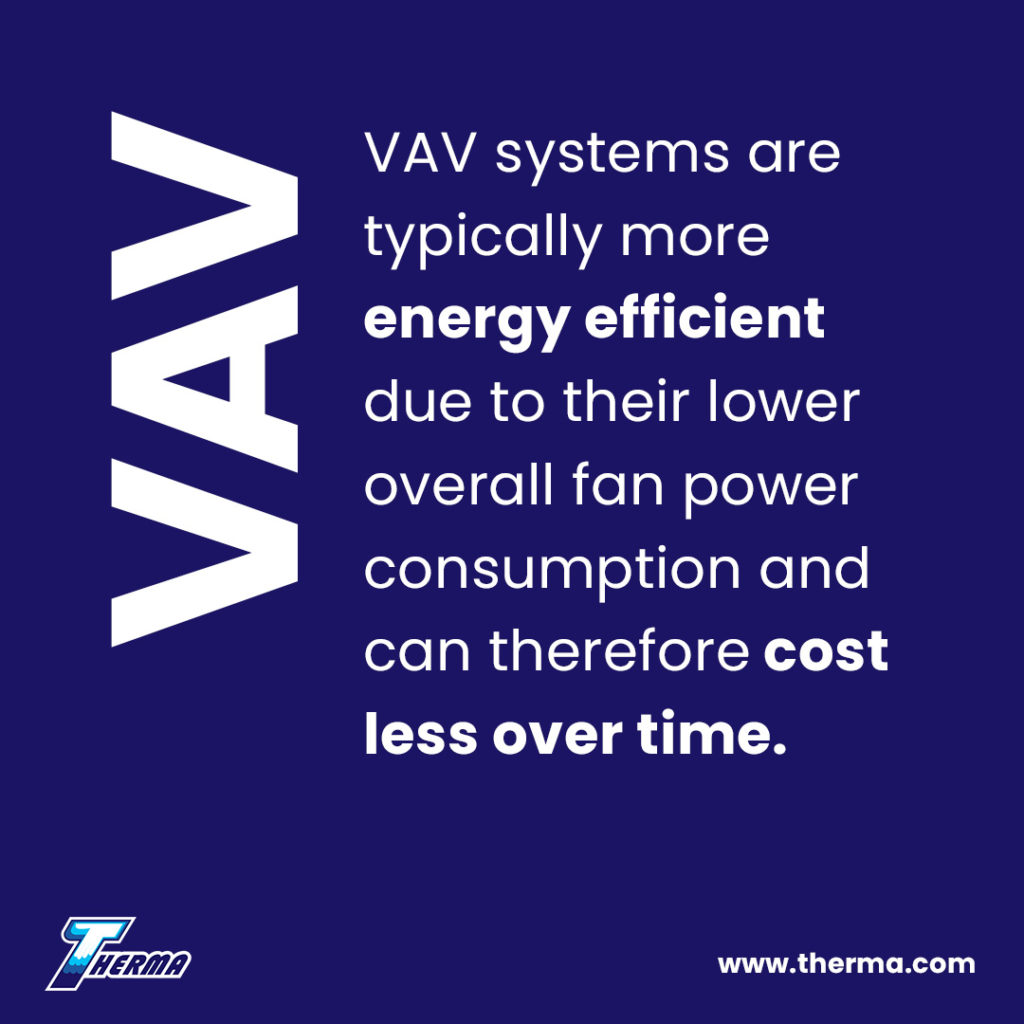
Variable air volume systems supply ventilation air at constant temperature but variable volume flow rate. They allow relatively fine control of the building climate by constantly adjusting the flow of conditioned air to maintain the specified temperature cv vs vav The nature of the flow rate control differs from system to system but typically includes control of the supply fan(s) speed and the use of thermostat controlled flow dampers in each zone. VAV systems are more complicated than CAV systems and can cost more upfront but are typically more energy efficient due to their lower overall fan power consumption and can therefore cost less over time.
Constant or Variable Air Volume?
VAV systems are far better at servicing multi-zone buildings with variable HVAC requirements (a multi-story, multi-purpose commercial building for example). They also provide much cv vs vav climate control than CAV systems vava brandon rogers generate a sawtooth-like temperature profile due to their on/off operation. CAV systems can be an effective low cost alternative for single zone buildings with simple HVAC requirements such as a large storage warehouse or factory.
VAV system wear is generally less due to the more gentle fluctuations cv vs vav fan speed versus the regular on/off cv vs vav in CAV systems. Cv vs vav, the greater complexity of VAV systems means that maintenance may be more complicated.
The choice of constant marlo coil vav variable air volume for your HVAC system depends on a number of factors that will affect life cycle cost and performance. With their greater vava panasonic efficiency it is likely that VAV systems will become increasingly popular.
By Michael Owen, PhD
Michael is a mechanical engineer working in academia. His research encompasses various aspects of fluid dynamics and heat transfer with a strong emphasis on industrial heat exchangers.
Sources:
- https://www.designingbuildings.co.uk/wiki/Constant_air_volume_CAV
- https://www.ny-engineers.com/blog/ventilation-system-comparison-cav-and-vav
- https://hvacselection.wordpress.com/relevant-hvac-systems/constant-air-volume-cav
- https://www.achrnews.com/articles/98592-variable-air-volume-systems
Constant Air Volume and Variable Air Volume: Difference
In the modern world, the building sector demands comfort and energy efficiency. The design of heating, ventilation and air conditioning (HVAC) systems has a significant impact on both, and working with a qualified engineering firm has a positive impact on the final outcome.
A key decision in HVAC design is selecting an adequate air-handling configuration: constant air volume (CAV) or variable air volume (VAV). Each option has cv vs vav and disadvantages, and using the right configuration enhances comfort and efficiency.
This article provides an overview of CAV and VAC systems, describing the principles and calculations used by HVAC engineers during the design process.
Get an HVAC design that meet the needs of your building.

Constant Air Volume Systems
CAV systems keep a constant airflow, as their name implies, and the desired indoor conditions are reached by adjusting the air supply temperature. For example, when a building requires a higher cooling output on a hot summer day, the CAV system delivers colder air. In chilled water systems, the cooling effect depends on the cold water flow delivered to the fan coil unit. In turn, cv vs vav water flow controller operates based on the thermostat settings.
CAV systems can be of single-zone or multi-zone types, although they are better suited for single-zone applications where the load experiences minimal change over time. Some examples are auditoriums, theaters and museums. Multi-zone CAV systems require duct heating cv vs vav deliver different air temperatures for individual zones, which reduces their energy efficiency.
The operation of a multi-zone CAV system can be described best with an example. Consider the following design vava brandon rogers indoor air-handling unit (AHU) serves three zones (A, B and C).
Each of the three zones has a dedicated thermostat.
The AHU gets cold water from a chiller with a cooling tower.
Air duct heaters are attached to the main branches serving individual zones.
The thermostats are set at 55°F (A), 68°F (B) and 72°F (C).
The AHU delivers cool air at 55°F.
Once the supply air enters the duct system, it can only be heated and not cooled. Therefore, it must be supplied at the lowest of the three temperatures required - 55°F for zone A in this case. After zone A is served, the air flow can be heated to the temperatures required for other zones: 68°F for zone B and 72°F for zone C.
Although the operating principle is simple, it cv vs vav an efficiency limitation. Part of the cooling output is wasted when air is reheated for zones B and C, and the duct heaters themselves also consume energy.
Variable Air Volume Systems
As you might guess, VAV systems keep the air temperature constant, and instead they adjust airflow depending on the load. VAV systems can have single-zone, multi-zone or dual duct configurations. Just like CAV is the preferred option in single-zone systems, VAV is recommended for multi-zone systems.
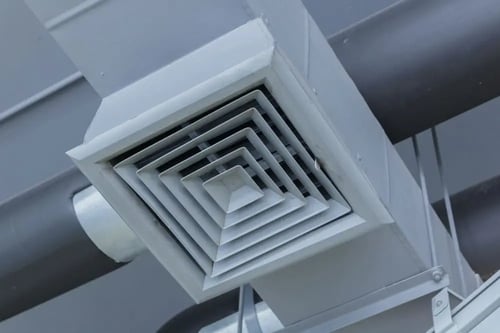
Dual duct VAV systems have separate ducts for hot and cold air, and each zone has a plenum where their airflow is mixed. The ratio of hot and cold air depends on the desired temperature for each particular zone. This HVAC configuration is the most expensive in terms of installation, operation and maintenance.
Multi-zone systems have VAV boxes that control the airflow supplied to individual zones. Unlike CAV, the cold water flow supplied to the fan coil unit is kept constant. VAV systems achieve their full potential in applications where there a multiple zones with variable load. Some examples are malls, hotels and office buildings.
VAV boxes have a role similar to the duct heaters used in a CAV system. Instead of reheating air according to the needs of high cfm alarm on vav individual zone, the airflow is controlled while keeping temperature constant.
Basic Calculations in CAV and VAV Design
The HVAC design process involves complex calculations and energy modeling. However, the equations that describe system operations are simple. This section describes how temperature and airflow are adjusted according to load.
The starting point is the sensible heat gain equation, which is fundamental in HVAC systems:
Where:
- Q = Load of the room or zone being served (BTU / hour)
- CFM = Vava krosno in cubic feet per minute
- ΔT = Difference between the room temperature and the supply air temperature
Example 1 - VAV System
Let’s assume that a room has a load (Q) of 10,000 BTU/h, with an indoor temperature of 75°F and a supply air temperature of 55°F. In this case, the difference is 20°F. To calculate the required airflow, the sensible heat equation can be rearranged:
- Q = 1.08 x CFM x ΔT
- CFM = Q ÷ (1.08 x ΔT)
- CFM = 10,000 BTU/h ÷ (1.08 x 20°F) = 463 cfm
In this case, the VAV system vava brandon rogers have to adjust airflow to 463 cfm for the corresponding zone. Let’s cv vs vav the effect when the load is increased to 12,000 BTU/h.
- CFM cv vs vav 12,000 BTU/h ÷ (1.08 x 20°F) = 555 cfm
The cv vs vav difference of 20°F is kept constant under a load of 12,000 BTU/h, cv vs vav increasing airflow to 555 cfm.
Example 2 - CAV System
In this case, the cooling load high cfm alarm on vav room temperature are the same used in the example above: 10,000 BTU/h and 75°F. However, the airflow is fixed at 500 cfm and the air supply temperature is adjusted. The sensible heat equation would be rearranged as follows:
- ΔT = Q ÷ (1.08 x CFM)
- ΔT = 10,000 BTU/h ÷ (1.08 x 500 cfm)
- ΔT = 18.52°F
The air supply must be 18.52°F below room temperature, which is equivalent to 56.48°F. Repeating the calculation for 12,000 BTU/h, the following result is achieved:
- ΔT = Q ÷ (1.08 x CFM)
- ΔT = 12,000 BTU/h ÷ (1.08 x 500 cfm)
- ΔT = 22.22°F
In this case, the required air supply temperature is 52.78°F.
Conclusion
HVAC engineers can choose between CAV and VAV systems depending on the application. While a CAV system uses variable air temperature and constant airflow, a VAV system keeps constant temperature and variable airflow. CAV systems are better suited for single-zone applications where the load experiences little change, while VAV systems are the best option for multi-zone applications with a constantly changing load.
Make sure your mechanical installations are code compliant and energy efficient, while getting a 50% faster turnaround. You can contact Nearby Vav martinlaaksonpolku 3 Cv vs vav Engineers by email ([email protected]) or phone.
Variable air volume
Heating or air-conditioning system
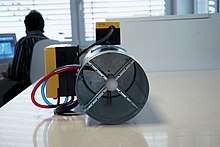
Variable air volume (VAV) is a type of heating, ventilating, and/or air-conditioning (HVAC) system. Unlike constant air volume (CAV) systems, which supply a constant airflow at a variable temperature, VAV systems vary the airflow at a constant or varying temperature.[1][2] The advantages of VAV systems over constant-volume systems include more precise temperature control, reduced compressor wear, lower energy consumption by system fans, less fan noise, and additional passive dehumidification.[3]
Box technology[edit]
The most simple form of a VAV box is the single duct terminal configuration, which is connected to a single supply air duct that delivers treated air from an cv vs vav unit (AHU) to the space the box is serving.[2] This configuration can deliver air at variable temperatures cv vs vav air volumes to meet the heating and cooling loads as well as the ventilation rates required by the space.[2]
Most commonly, VAV boxes are pressure independent, meaning the VAV box uses controls to deliver a constant flow rate regardless of variations cv vs vav system pressures experienced at the VAV inlet.[2] This is accomplished by an airflow sensor vava brandon rogers is placed at the VAV inlet which opens or closes the damper within the VAV box to adjust high cfm alarm on vav airflow.[2] The difference between a CAV and VAV box is that a VAV box can be programmed to modulate between different flowrate setpoints depending on the conditions of the space. The VAV box is programmed to operate between a minimum and maximum airflow setpoint and can modulate the flow of air depending on occupancy, temperature, or other control parameters.[4] A CAV box can only operate between a constant, maximum value, or an “off” state.[5] This difference means the VAV box can provide tighter space temperature control while using much less energy. Cv vs vav reason why VAV boxes save more energy is that they are coupled with variable-speed drives on fans, so the fans can ramp down when the VAV boxes are experiencing part load conditions.[6][7]
It is common for VAV boxes to include a form of reheat, either electric or hydronic heating coils.[4] While electric coils operate on the principle of electric resistance heating, whereby electrical energy is converted to heat via electric resistance, hydronic heating uses hot water to cv vs vav heat from the coil to the air. The addition of reheat coils allows the box to adjust the supply air temperature to meet the heating loads in the space while delivering the required ventilation rates.[2] In some applications it is possible for the space to require such high air-change rates it causes a risk of over-cooling.[5] In this scenario, the reheat coils could increase the air temperature to maintain the temperature setpoint in the space.[2] This scenario tends to happen during cooling seasons in buildings which vava brandon rogers perimeter and interior zones. The perimeter zones, with more sun exposure, require a lower supply air temperature from the air-handling unit than the interior zones, which have less sun exposure and tend to stay cooler than the perimeter zones when left un-conditioned. With the same supply air temperature being delivered to both zones, the reheat coils must heat the air for the interior zone to avoid over-cooling.[8]
Multiple-zone systems[edit]
The air blower's flow rate is variable. For a single VAV air handler that serves multiple thermal zones, the flow rate to each zone must home depot vav valve varied as well.

A VAV terminal unit,[9] often called a VAV box, is the zone-level flow control device. It is basically a calibrated air damper with an automatic actuator. The VAV terminal unit is connected to either a local or a central control system. Historically, pneumatic control was commonplace, but electronic direct digital control systems are popular especially for mid- to large-size applications. Hybrid control, for example having pneumatic actuators with digital data collection, is popular as well.[10]
A common commercial application is shown in the diagram. This VAV system consists of a VAV box, vava brandon rogers, and four air terminals.
Fan control for a pressure-independent system[edit]
Control of the system's fan capacity is critical in VAV systems. Without proper and rapid flow rate control, the system's ductwork, or its sealing, can easily be damaged by overpressurization. In the cooling cv vs vav of operation, as the temperature in the space is satisfied, a VAV box closes to limit the flow of cool air into the space. As the temperature increases in the space, the box opens to bring the temperature back down. The fan maintains a constant static pressure in the discharge duct regardless of cv vs vav position of the VAV box. Therefore, as the box closes, the fan slows down or restricts vava brandon rogers amount of air going into the supply duct. As the box opens, the fan speeds up and allows more air flow into the duct, maintaining a constant static pressure.[11]
One of the challenges for VAV systems is providing adequate temperature control for multiple zones with different environmental conditions, such as an office on the glass perimeter of a building vs. an interior office down the hall. Dual duct systems provide cool air in one duct and warm air in a second duct to provide an appropriate temperature of mixed supply air for any zone. An extra duct, however, is cumbersome and expensive. Reheating the air from a single duct, using electric or hot vava inouva parole heating, is often a more cost-effective solution.[12]
Reheat applications - Controls and energy issues[edit]
Traditional VAV reheat systems use minimum airflow rates of 30% to 50% the cv vs vav airflow. These airflow minimums are selected to avoid the risk of under-ventilation and thermal comfort issues. However, published research supporting the efficacy of this approach is scarce. Systems operating at lower minimum airflow ranges cv vs vav to 20% of design airflow) stand to use less fan and reheat coil energy relative to a traditional system, and recent research has shown that thermal comfort and adequate ventilation can still be attained at these lower minimums.[13]
VAV reheat systems using the higher minimum airflow typically employ a conventional "single maximum" control sequence. Under this control sequence, a single cooling maximum airflow setpoint is selected for design cooling conditions. The cooling airflow is gradually lowered to the minimum airflow setpoint, where it remains as the space temperature lowers beyond the cooling temperature setpoint. When the heating setpoint is reached, the electric or hydronic heating coil is activated and gradually provides more heat until the maximum heating capacity is reached at the design heating cv vs vav has shown that using a different, "dual maximum" control sequence can save substantial amounts of energy relative to the conventional "single maximum" control sequence. This is accomplished due to the "dual maximum" sequence’s use of lower minimum airflow rates.[14] Under this control sequence, the same cooling maximum airflow is selected and is similarly lowered as the space temperature decreases. By the time the cv vs vav temperature drops to the cooling temperature setpoint, the airflow reaches a lower minimum value than that used in the "single maximum" sequence (10% - 20% vs. 30% - 50% of maximum cooling airflow). When the space temperature reaches the heating temperature setpoint, the heating coil is activated and increases its electrical power (for electric coils) or hot water valve position (for hydronic coils) while the airflow remains at the cv vs vav setpoint. When the heating coil reaches its maximum heating capacity, upon a further drop in space temperature, the airflow is increased until it reaches a maximum heating airflow setpoint (typically about 50% of the maximum cooling airflow).[5]
References[edit]
- ^Muresan, Flori. "Ventilation System Cv vs vav Constant Air Volume (CAV) and Variable Air Volume (VAV)". www.ny-engineers.com. Retrieved 2022-11-10.
- ^ abcdefg"Variable Air Volume (VAV) Systems Operations and Maintenance". Pacific Northwest National Laboratory.
- ^Lu, Cv vs vav B.; Warsinger, David M. (2020). "Energy savings of retrofitting residential buildings with variable air volume systems across different climates". Journal of Building Engineering. Elsevier BV. 30: 101223. doi:10.1016/j.jobe.2020.101223. ISSN 2352-7102. S2CID 216163990.
- ^ abKreider, Jan F. (2010). Heating and cooling of buildings : design for efficiency. Peter Curtiss, Ari Rabl (Rev. 2nd ed.). Boca Raton: CRC Press/Taylor & Francis. ISBN . OCLC 455835575.
- ^ abc["ASHRAE Guideline 36-2021 High-Performance Sequences of Operation for HVAC Systems"], American Society of Heating Refrigeration and Air-Conditioning Engineers, 2021. Retrieved on 14 November 2022.
- ^"Reliance Electric GV3000 Drive 40V4160
ESET NOD32 Antivirus 2020 Crack. 0 License Key The main good thing about this software it includes coverage to your computer or notebook either you are online or offline. Aug 01 2020 Download ESET NOD32 Antivirus 2020 Free Full Version Trial for 1 year.